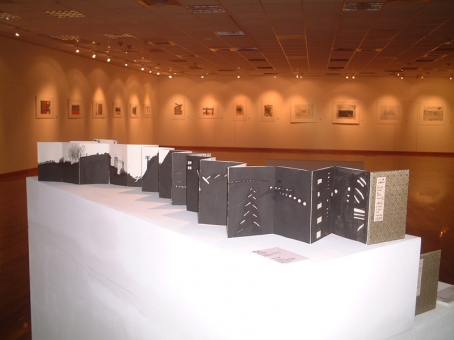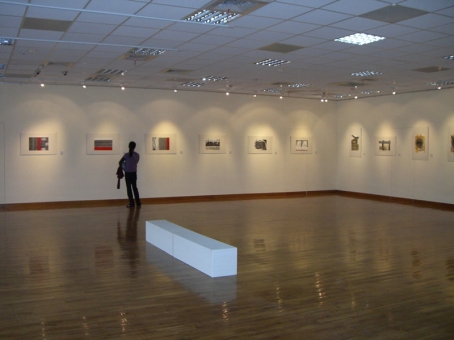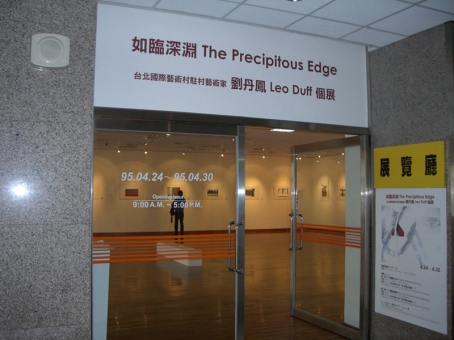The Precipitous Edge
Taipei Artist Village (TAV) has been of late enthusiastically throwing itself into cultural and artistic exchange activities. It settles Taiwanese artists in art villages in different cities across the globe as well as introducing foreign artists with various backgrounds and techniques to Taiwan. I believe that cultural exchange, like traveling, may broaden our horizons, increase life experiences, and help us get to know ourselves— perhaps the most important goal. In other words, it means that other cultures are mirrors which face us from a distance, and we see, judge, and understand ourselves from them. Irish-origin British painter Leo Duff (劉丹鳳) gives me the feeling of “reflecting myself from a mirror”. When I examined her works, I constantly thought of how her ways of observation and techniques of creation and how her points of views may bring new inspiration to Taiwanese artists.
As regards materials, Leo usually uses paper, not canvas. The reason why she prefers paper is very similar to Orientals: paper is very “sensitive”. Many years ago, I told one American friend that Chinese writing brushes and rice paper are very sensitive, and then he joked:” Do they cry if you don’t use them?” The cultural differences may be found behind this joke: Westerns emphasize the authority of a human; usually they think “sensitive” should be used to describe activities of artists’ creation, not materials. In contrast, Orientals continually seek the balance between the subjective “I” and passive “object”; we use “activate the ink (發墨)” this phrase to describe paper, as it is an individual with expression. In the same way, Leo prefers paper than canvas since paper has a particular expression. Canvas allows pigments to adhere themselves to it, and carries brushes and colors which can cover the previous layers. But Leo prefers and enjoys the feeling of how paper absorbs most pigments and how water and other pigments infiltrates and spreads in through the fibers, which is not only a process but also a dialogue between artist and materials. In this dialogue words spread into air, hide, congeal on the surface, or continually flow. Maybe the playfulness and hiding of “doing seems undoing” and the changeable surface is one of the most enjoyable aspects of using paper as a creative material.
However, I believe that ’hiding’ is for ’showing’, which says more. With the same attitude, Leo uses white on white, black on black; or applies barely identified pencil stokes on very dark textures, and silver on gray for utilizing an easy way to express the abundant contents and meanings of different layers. For this purpose, Leo keeps discovering new materials— she even went to local hardware stores seeking new painting and drawing substances.
The way that Leo uses for observing attracts to me. The best examples can be brought up are from her works, North Gate and two sketchbooks drawn in Taiwan. There are three main components about North Gate: roads, the gate, and traffic signs. Leo draws several wide and tidy strokes, which cut and cover parts of the gate, reviling the cramped situation that has occurred to a precious and historic construction. The thinner lines applied on this painting are for the prohibiting signs, such as for no parking, for no parking temporarily drawn on the roads which are closed to the gate. Underlying all this are traces of the historical aspects of the gate and its past importance. One of Leo’s traveling sketchbooks was drawn in response to what she saw; villages, farms, towns, and factories when she was on the train to Kaohsiung and Taitong one morning; while back to Taipei one night was drawn on another one - this one is fabulous. Leo used a pen to sketch outlines of night scenes and filled it up with black ink at her studio at TAV. The shadows reflected by the lighting on platforms, antennas on the roofs, and humble windows along the railroads take shape as keenly outlined as paper-cut images and make me feel in a trance. We are so familiar with these sights; however, they are far away and cold in her paintings at the same time, as if we are observing foreign lands. I have seen black and white paper-cut works made by African-American artists who try to evoke the origins and self-identities, but Leo’s works are not like those. From her British descent, she must already have sensed the unstable, exhausted, and unpleasant feelings inside and have seen the broken and crude huts outside, these are the truths we all know, and invoke us the sympathies and helplessness. But Leo’s sketchbooks gives me an implication of “sweeten Ireland’s wrong” (note I) which keeps showing on the sketchbooks. Because of the distance and cold feeling remind me the James Joyce’s definition and requirement of art;”任何戲劇性…之上”, The meaning is so close to Zen’s spirit. Through art, how amazing to see Western and Easter’s spirits were connected.
Since Leo’s works were being exhibited at the gallery of the National Taiwan University of the Arts, I would like to emphasize the specialty and inspiration of her works to local artists and students. Usually, there are five elements in the abstractive painting: line, point, image, space, and color. When we choose an object as a topic to create our works, we often focus on the development of its points, lines, and surfaces, instead of its “real structure”. We are good at calligraphy as an expression, which results in the loosing of a “process of distillation” - the abstractive painting becomes a kind of painting “reserved” by calligraphic aesthetics. In the fine arts, we have seen too many artists use abstract style such as sear-stroked textures in their compositions. Leo’s works are between abstractive and real structures. Leo also teaches “Drawing as Process” (a masters programme) at Kingston University. Those two conditions in her approach and her ways of expression in her series paintings / drawings in The Precipitous Edge and their relationship to the issues in Taiwan may give Taiwanese artists and students some substantial lessons. How she distils, cuts out, and internalizes “images” which we are familiar with, and transforms them to semi-abstractive elements, yet which present us clear, brief and strong messages.
Another thing that interests me is the political implication in Leo’s drawings which look like landscapes or maps with contour lines, but the content sharply implies political issues. The land in Korea is covered by rocks, and in Taiwan is covered by concrete. The construction and destruction of Stone on Broken Stone have described many true stories of the land, the ecology, and the development of a society. When I was her studio, Leo pointed at a drawing and told me that; “This is a river. Several years ago, it was covered by concrete, a main road and also a flyover. An architect had the vision to remove these layers of concrete from the river and restore its original course and this revolutionary development for the city were has been acclaimed as an enormous success across the world, but the architect has lost his job.” We are familiar with this kind of story. The whole process reflects the whole of society’s ignorance on environmental and ecological issues throughout time. Finally people start to pay attention to their importance; however, the executers of reformations then become embroiled in political conflicts and become engaged with the fraudulence which accompanies politics.
Because of such a complicated social background and once unstable situation in Leo’s home country- Ireland has survived its difficult situation- she becomes our confidante. When she faces up to such sharp topics, she turns out the internalization and introspection in her works not as agitation and screams. It’s like when we are close to a still lake, bend our heads, contemplate and see our reflections on the water.
Chuan-Chu Lin, Artist. Taiwan, 2006.
Note 1: Poetry of W. B. Yeats《給未來的愛爾蘭》
Note 2: Chapter V of James Joyce’s A Portrait of the Artist as a Young Man


